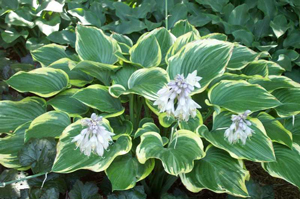Story and photos by Michelle Sutton unless noted
Rawlings Nursery: Hostas & Display Gardens in the North Country
PLANT FAMILY
Generally hardy to Zone 3a, hostas are at home in Zone 4b in Ellisburg, New York, an hour north of Syracuse and just east of Lake Ontario. There, on the former family dairy farm, Kevin Rawlings has grown over a thousand cultivars of hostas and generally offers 200-plus cultivars for sale. The farm’s soil is a desirable pocket of clay loam in a sea of sandy soils created by glacier retreat. The winds off Lake Ontario howl across the farm year round, but the hostas stand up to it well.
Many of Rawlings’ family members were school teachers, including his parents, who ran the dairy farm as a back-up source of income until they retired around 1979. At that point, the family put up a greenhouse and started growing annuals, creating sumptuous display gardens that served as outdoor event grounds for weddings and the like. “At peak we had 12,000 annual plants on display,” Rawlings says. “In one bed alone (140 x 60 feet), we planted 8,000 annuals. It took five of us the whole of Memorial Day Weekend to plant,” he says.
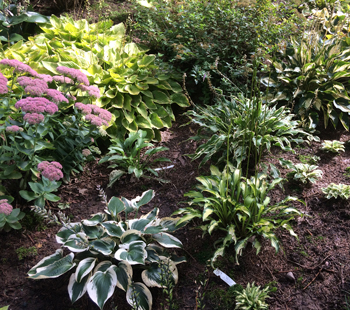
Hosta display garden at Rawlings Nursery.

Spring in the hosta house. Photo courtesy Rawlings Nursery

Kevin Rawlings
Eventually the family had to change gears once again, because sales of annuals by big box stores were driving prices down. Kevin Rawlings had a passion for unusual trees—and has planted quite a few that are maturing on the farm—but he found that hostas were more profitable. “I thought they were fantastic and they had the commercial advantages of transporting well and looking good in a pot,” he says. He sold hostas with his children at the Syracuse Farmers market for 25 years, and says “we meet some wonderful people and made dear friends,” but now he sells only by appointment from the farm in Ellisburg. Some longtime customers make the trek once a year from Rochester and points west to see the latest cultivars.
For many years, hosta cultivars were propagated only by division. When hostas began to be propagated by tissue culture (the accelerated growth of plant cells in an artificial medium in a sterile lab environment), there was an explosion in both quantity of plants produced and in cultivar range. Tissue culture has been a boon for hosta collectors but has been a little less kind to hosta growers, because increased supply has put downward pressure on selling price.
HOSTA FACT V. FICTION
“Do they flower?” is a question Rawlings hears surprisingly often. He responds, “The only way hostas are not going to flower is if they are growing in too dark a spot. All hosta cultivars possess floral meristems (groups of cells that give rise to flowers) inside the terminal bud, but if the plant doesn’t get enough sun, it won’t advance through its seasonal growth to the point of flowering.”
Some folks ask for the white hostas they’ve seen pictures of. “There are several cultivars that come out of the ground white, but they don’t stay white throughout the season, Rawlings says. “They turn green out of necessity so they can perform photosynthesis. Increasing temperatures cue the conversion.” A few customers have asked for a red hosta… which doesn’t exist but in pictures.
People who are newer to growing hostas may ask for “the blue one.” But the “blue” is not immutable; it’s the effect of white wax on green leaves. “I rub the underside of the leaf and show them how the wax comes right off,” Rawlings says. “It’s the base color of the green leaf and the thickness of the white wax that determines how blue or gray the leaves look,” he says.
Yellow hostas aren’t immutably yellow either, Rawlings explains. “They do one of two things, depending on cultivar,” he says. “They can come out of the ground brightly colored and then become chartreuse or dull green afterwards; they green up to protect themselves. Or, they do the opposite and come out green, then fade to chartreuse, then convert to bright yellow as the season progresses.”
Even large-leaved varieties have small leaves when they are young plants. It can take 5, 6, even 7 years for a large-leafed hosta like ‘Sum and Substance’ to come into its full leaf size. Therefore, it can be easy to see a dwarf plant and think that it’s going to mature as a medium or large hosta when in actuality, it’s going to stay small.
MORE ABOUT RAWLINGS
Kevin’s Favorite Hosta
(Out of 5400 Registered Varieties)
According to the description in the Rawlings Nursery online catalog, ‘Sagae’ (pron. SAH-GAH-ay) grows 32 inches high and 60 inches wide. It forms a vase-shaped mound of large, thick frosty green leaves with gold margins. It’s consistently number one or two on the American Hosta Society popularity list, and it was the 2000 American Hosta Growers Hosta of the Year selection.Kevin’s favorite hosta cultivar is ‘Sagae’. Photo Courtesy MOBOT Plant Finder
Contact Rawlings Nursery
WEBSITE: rawlingsnursery.com
FACEBOOK: facebook.com/RawlingsNursery
EMAIL:
ho******@gm***.com
PHONE: (315) 396-9763
ADDRESS*: 12061 Monitor Mill Rd
Ellisburg, NY 13636*Nursery open by appointment
Marcellus Nursery: 56 Years of Growing in Onondaga County
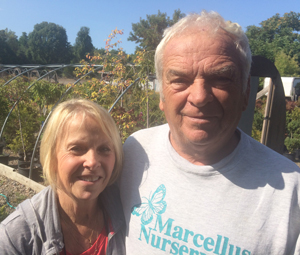
Ted and Nan Stetler
When I interviewed Ted and Nan Stetler, they were just back from an Alaskan cruise. I assumed they’d be loath to return to work, but Nan says Ted was “bored out of his gourd” on vacation. That can happen when you’ve been working as hard as he and Nan have for so many years, running Marcellus Nursery: it can be challenging to be away from your own business.
Ted, who earned an agriculture degree from SUNY Farmingdale (then known as Long Island Agriculture & Technical Institute) in 1961, started Marcellus Nursery in 1962 with the purchase of 44 acres in the Town of Marcellus, southwest of Syracuse. When the nursery’s garden center moved 12 miles to the Town of Onondaga in 1970, the Stetlers chose to retain the name Marcellus Nursery for name recognition and branding reasons.
Ted and Nan met in 1966, got married in 1967, and started their family in 1975. They have two daughters, Beth and Jill. Nan has been integral to the nursery’s success, as has Rachel Reynolds, the garden center manager of more than 20 years. Nan says, “She’s like a daughter to us.”
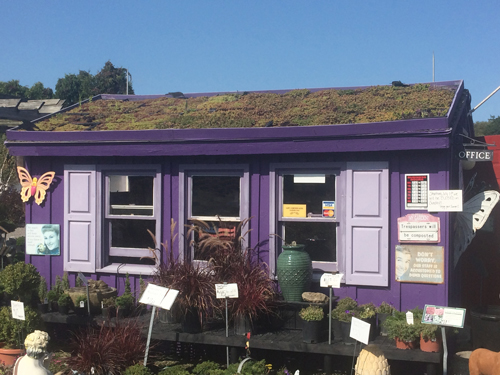
Green roof planted with sedums keeps the checkout building cool.
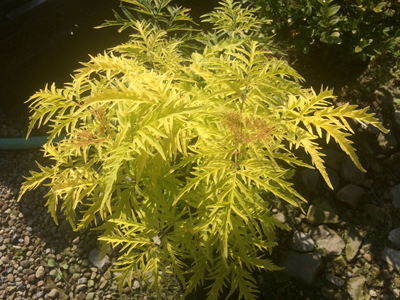
‘Lemony Lace’ elderberry (Sambucus racemosa).

Fabulous sculptures abound.
Marcellus Nursery runs on multiple tracks, with only five full-time folks, Ted included. There’s the 85,000 fieldgrown trees and shrubs, the landscaping business, the potting-up work of the largest selection of perennials in the area, and the retail garden center. There’s the plant propagation work, which Ted does as a means of unwinding at the end of a busy day during the growing season. There are beautiful display gardens for customers to explore, at the center of which is a 53-year-old weeping European beech (Fagus sylvatica ‘Pendula’).
Field-growing so much material means that the plants on offer at Marcellus Nursery are acclimated to the often harsh upstate NY winters. Furthermore, most of the field crops are not irrigated. “If they survive and adapt to those conditions, they are going to perform well for local customers,” Nan says. Mercifully and surprisingly, deer have not been a problem in the tree and shrub nursery fields. However, they have been an issue in the production areas of the garden center site, so the Stetlers are upgrading their 5-foot perimeter fence to 8 foot tall.
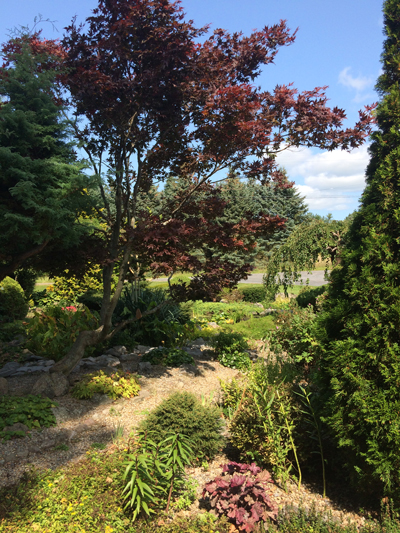
Customers are invited to wander display gardens.
In addition to growing bread-and-butter plants, Ted likes to try out some “fantasy plants,” as he calls them, each year. “I’ll buy ten of this and ten of that of unusual plants and try them out,” he says. He is trying to interest folks in weeping dwarf spruce and dwarf pines, but he gave up field-growing Japanese maples after several devastating winters wiped out whole rows of trees.
During the growing season, a typical day for Ted goes like this. Paperwork at his desk from 5:30 a.m. to 8 a.m. Then at 8 a.m. he joins his staff and works alongside them until 4:30 p.m. when he goes home to regroup for an hour before going out on client consultations in the evening. Home by 8 or 8:30 p.m., he does plant propagation work to unwind, and he and Nan have dinner at about 10 p.m. It’s a pretty grueling schedule, so Ted is looking for efficiencies everywhere he can— for instance, by using a motorized wheelbarrow on landscaping jobs.

Good advice at the garden center checkout.
As owners of Sycamore Hill Gardens (sycamorehillgardens.com) in Marcellus, George and Karen Hanford have a long association with Ted and Nan Stetler and Marcellus Nursery. George says, “Ted is the father of our gardens. Ted and Nan took us under their wing and introduced us to the world of plant propagation and the joys of designing, maintaining, and sharing a large plant collection. Without their guidance and friendship there would be no Sycamore Hill Gardens, no annual fundraisers for local charities, no national American Conifer Society meeting or local New York State Nursery and Landscape meetings held here in our gardens. We can’t thank Ted and Nan enough for their help and kindness.”
Contact Marcellus Nursery
WEBSITE: marcellusnursery.com
EMAIL:
co*****@ma**************.com
PHONE: (315) 488-2632
Michelle Sutton (michellejudysutton.com) is a horticulturist, editor, and writer.
Views: 1





